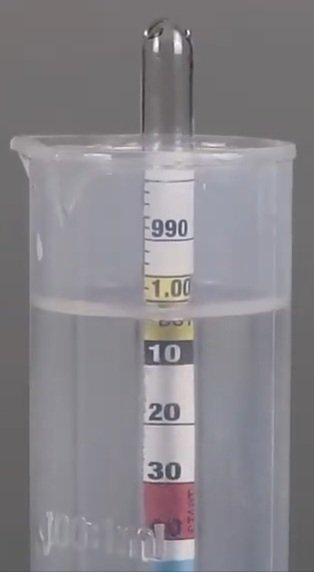
With the must prepared and the yeast pitched, it’s nearly time to let your mead sit and ferment. If we leave this mead to sit without taking any further measurements, we can never know the alcohol-by-volume (ABV) of the mead.
That’s why mead-makers use a tool called a hydrometer to take a gravity reading.

Gravity
Gravity is a measurement of liquid density. Gravity readings are made to three decimal places. An example of how this would be written down is 1.050.
A must with a higher gravity will ferment to a higher ABV than a mead with a lower gravity, provided the yeast you choose to ferment with has an alcohol tolerance high enough to ferment the mead dry.
Dry in mead-making is a term used to describe a mead that has no remaining sweetness once it has fermented. These meads will have a gravity between 1.000 and 0.985. We’ll be covering in a later lesson how to re-add sweetness to a dry mead safely.
Gravity readings are taken to calculate ABV, to check on the speed of the ferment, and to determine when a ferment has concluded. We use a tool called a hydrometer to take these readings.

Using a Hydrometer
To take a gravity reading, place your hydrometer into your vessel, allow it to float, and read the hydrometer from the surface of the mead.
Some vessels are too shallow or would be difficult to retrieve your hydrometer in the instance of a demijohn. In these instances, you can use a sanitised wine thief or turkey baster to transfer some mead into a beaker tall enough for the hydrometer. Usually, thin beakers with a volume of 100ml or more are sufficient.
If there are bubbles in your mead that are making it hard to get a clear reading, you can gently spin your hydrometer to make the bubbles float away.
Every line on the hydrometer indicates .002 gravity. In the photo above, we can read the hydrometer as having a gravity of 1.044. While the liquid creates a lip around the hydrometer that could be read as 1.042, we must take our reading from the level of the liquid.

Checking Accuracy
To test if your hydrometer is accurate, you can place it in water, and it should read 1.000. Most hydrometers are calibrated to 20°C, but be sure to check your hydrometer packaging and ensure the water is at the correct temperature prior to testing your hydrometer’s accuracy.

Calculating ABV
We need to take two gravity readings to be able to determine a mead’s ABV.
The first is a reading just after the yeast has been pitched, called original gravity (OG).
The second gravity reading we take once fermentation has concluded is called final gravity (FG).
Using the below formula, we can calculate our mead’s ABV:
(OG - FG) x 131.25 = ABV
We have a simple ABV calculator that will do the calculation for you.



